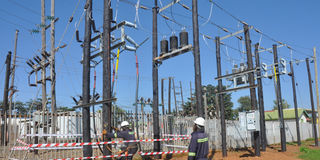ERA maintains power tariffs

Engineers carry out works at Layibi substation in Gulu town. ERA maintained the tariff despite changes in parameters used to determine the cost of electricity. PHOTO | FILE
Electricity Regulatory Authority (ERA) has retained the tariff paid across all customer categories for the fourth quarter of the year as it was in July.
The tariff schedule released by the power regulator which is in charge of setting the price of electricity, indicates that the cost of electricity for the three months starting October to December will remain the same as it was in July.
Households will enjoy the first 15 units at a subsidised rate of Shs250 before paying Shs750.9 for the rest of the units during the period.
Commercial customers will continue paying Shs645.6 per unit of electricity while medium industrial customers incur Shs570.9 per unit.
Large industrial customers are paying Shs361 for a unit of power while extra-large customers fork out Shs301.7 for every unit of power consumed.
What determines cost?
The tariff was maintained despite changes in parameters used to determine the cost of electricity.
The new tariff is premised on an exchange rate of Shs3677.5 against the dollar which was mid-rate of the Uganda Shilling against the United States Dollar as published by Bank of Uganda on August 31.
Core Consumer price index considered was at 183.8 while producer price index was at 210.3.
International fuel prices considered for the tariff this quarter increased to 45.1 compared to 25.1 for July
Oil prices started recovering and are expected to recover as the world eases lockdown measures globally, creating demand for the resource.
Understanding tariffs
A tariff is a price paid by the consumer per unit (kwh) of electricity consumed.
End-user retail tariff is a price paid by the final consumers of the distribution cost for each unit of electricity billed.
This tariff is made up two components - the power supply price and distribution price component.
The power supply price is meant to recover the bulk power purchase costs while the distribution price component is meant to recover the distribution costs.


